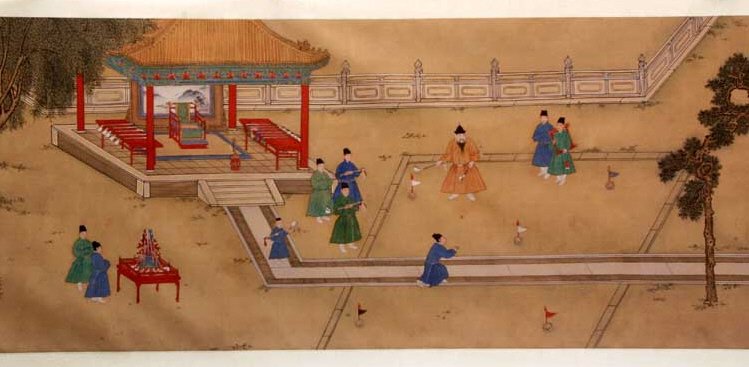The Cultural Significance Of Golf Around The World

Ming Xuande Xing Le Tu, collection of the Palace Museum (Forbidden City). The Ming Emperor Xuande playing a game that looks like golf, called chuiwan.
Golf is not just a game. It is a whole world with its history, culture, and amazing achievements. Join us on this journey through the world of golf.
Due to its roots and traditions, golf has evolved and transformed while remaining factual. Delve into the fascinating world of golf, revealing its extraordinary stories, famous records, and achievements. Consider the most important tournaments and events. Golf influences the world's culture, economics, and politics and contributes to technological innovation.
History of the Golf Game
Golf has a long but fascinating history:
Ancient Roots: Although the actual origins of golf seem ambiguous, there is proof of comparable games in different cultures. In the Roman Empire, there was a game called paganica, where participants used curved sticks to hit a leather ball. Similar games have also been found in the Netherlands, China and France.
Scottish Roots: Golf originated in Scotland in the 15th century. It is interesting to know that in 1457, King James II of Scotland prohibited the game because he thought it distracted men from archery, which was crucial for national defence.
Unusual Facts About Golf
Golf is full of amazing and often unexpected stories and facts:
The oldest golf course is the Old Links in Musselburgh, where Mary Stuart, daughter of the Scottish king James V, played back in 1567.
In Scotland, the first rules of golf and an 18-hole course were approved in writing.
The first golf tournaments began to be held in Scotland, and then this game spread throughout England.
Astronaut Alan Shepard became the first to hit a ball with a club outside of our planet. Let us remember that the force of gravity on the Moon is much less than on Earth, so the ball ended up flying several kilometers away.
Before 1930, the golf ball came in a variety of shapes. There was no single standard until the United States Golf Association established a clear ball weight and size based on the requirement that ball speeds should not exceed 250 feet per second.
The first golf clubs were made of wood: hickory wood was used for the handle, and Virginia persimmon was best suited for the hook due to its high strength and hardness. But with the advent of durable gutta-percha balls in 1850, metal clubs appeared. In 1890, steel clubs began to be produced. The first metal wood stick appeared in the early 1980s.
Thanks to the development of technology, the stick handle began to be made of graphite, and the blade was made of lightweight titanium. The high strength and lightness of this metal made it possible to make the hook thinner, which increased the flight distance of the ball. That's not all that might interest you! If you need to write a research paper on a golf topic, check out boostmygrades review, and there, you will find useful and relevant information.
The MacDonald boys playing golf, attributed to William Mosman. 18th century, National Galleries of Scotland.
Worldwide Records and Achievements in Golf
Golf is rich in amazing records and achievements that highlight the skill and resilience of its players. One could often hear: “I was looking for some essayservice review to find out what are some of the notable achievements in this sport.” Well, we will tell you about a few of them:
The best golf athletes regularly set records and demonstrate outstanding results. For example, the longest officially recorded kick was hit by American Michael Hawk Austin in 1974. On a standard course, he sent the ball 471 meters. When fixing the record, there was a tailwind, which certainly helped Austin demonstrate such a result. At the moment of impact, the wind speed was 56 km/h.
The largest golf tournament took place in Great Britain in 1984. About 321,779 athletes participated in it, 206,820 of whom were men, and the rest were women.
In 1981, a record was set for the maximum advantage of a competition winner over competitors. American Jerry Pate beat all his opponents at the US golf tournament by 21 strokes.
In golf, a replay is assigned when athletes of equal strength meet in opposite situations. The longest replay took place in 1931 between Americans Billy Burke and George von Elme. Burke won the replay after 72 extra holes.
Golf at the Olympic Games
Golf was included in the official program of the Olympic Games at the dawn of this movement. However, for many years, this game was not presented at the most prestigious competitions for athletes on the planet.
Golfers made their debut at the Olympics, which took place in 1900 in Paris. At the competition, the organizers raffled off two sets of awards. The winners were determined in individual disciplines among men and women. Among men, the first Olympic champion was American Charles Sands. Briton Walter Rutherford took second place, and bronze went to David Robertson, another representative of Great Britain.
For women, Margaret Ebbor won the first gold medal in golf at the Olympics. Representatives of the USA occupied the entire podium in the women's competition. Pauline Witter took second place, and Daria Pratt took third. If you’re assigned to write about the biographies of famous female golfers, then go to the website to help write essays, which specializes in this topic.
In 1904, at the Olympic Games in St. Louis, America, the Olympic champions in golf among men were determined in the singles and team competitions. However, women did not participate in the competition. The US teams took all three prizes in the team competition.
Canadian George Lyon won the singles event, but second and third places also went to American golfers. After the Games in St. Louis, golf lost its status as an official sport in the Olympic Games program for a long time.
